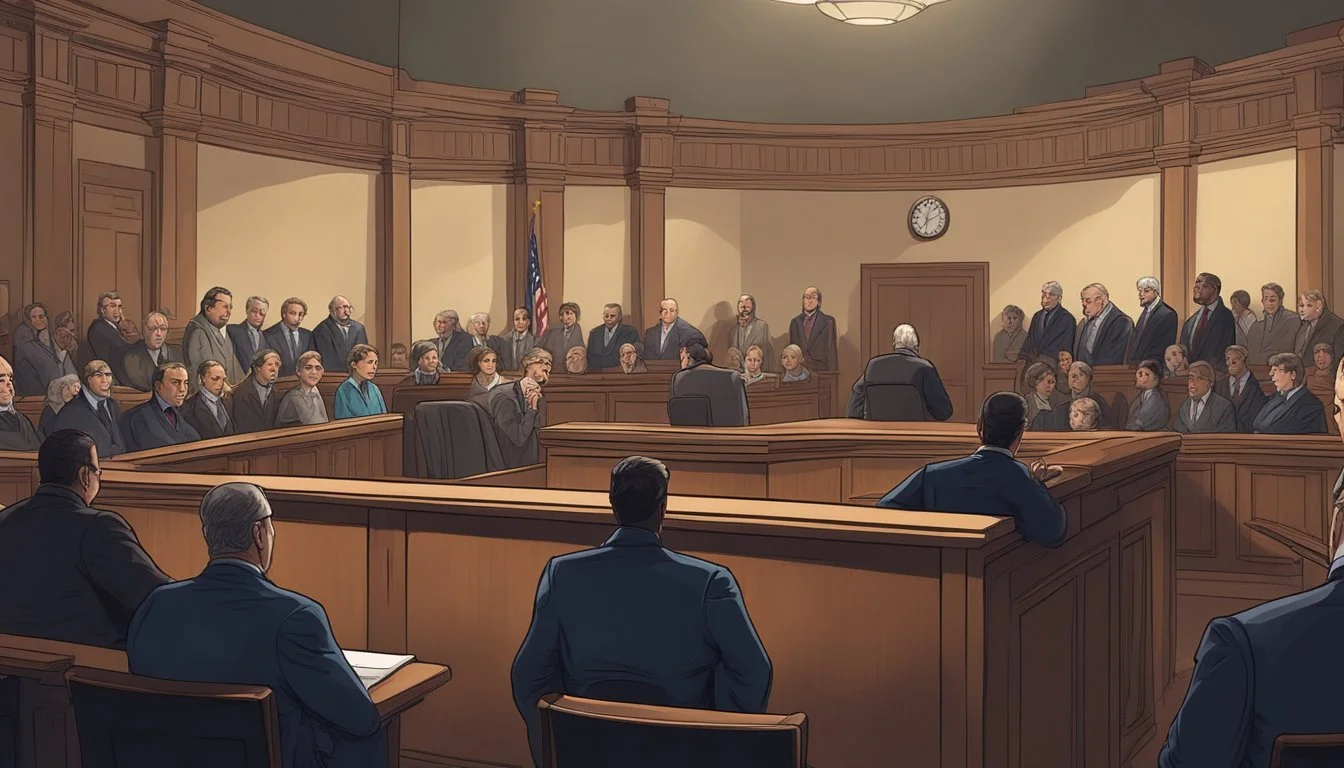Peoria's Predator: Larry Bright's Midwest Massacre
Serial Killer's Reign of Terror Exposed
Larry Bright, known as "The Bonecrusher," terrorized central Illinois from 2003 to 2004. His brutal killing spree claimed the lives of at least eight women in Peoria and Tazewell Counties. Bright's reign of terror ended when he confessed to his crimes, leading to his conviction and eight life sentences without parole.
The victims, mostly from vulnerable populations, were found in various locations across the area. Some bodies were dumped, while others were burned in an attempt to conceal evidence. Bright's capture brought a sense of relief to the community, but left deep scars for the families of those he murdered.
Despite his initial confession, Bright later retracted his statements and claimed innocence. He is currently serving his sentences at Shawnee Correctional Center. The case continues to haunt Peoria, with lasting impacts on victims' families, like Briana Gardner, who lost her mother Laura Lollar to Bright's murderous rampage.
The Disturbing Case of Larry Bright
Larry Bright, an American serial killer, terrorized central Illinois from 2003 to 2004. His crimes primarily focused on Peoria and Tazewell Counties, where he claimed the lives of at least eight women.
Bright's victims ranged in age from 30 to 41. He earned the chilling nickname "The Bonecrusher" due to his horrific practice of burning victims' bodies after murdering them.
The killer's rampage began in July 2003 and continued until October 2004. During this period, Bright targeted women in the Peoria area, leaving a trail of devastation in his wake.
Law enforcement eventually arrested Bright in connection with these murders. He was charged with the first-degree murder of Linda Neal, a 40-year-old Peoria resident, in 2003.
Bright's case shocked the community of Peoria and surrounding areas. His actions left families grieving and a region grappling with the presence of a serial killer in their midst.
Investigations revealed that Bright had implicated himself in seven additional murders beyond Neal's. This admission exposed the full extent of his crimes and the impact on central Illinois.
Timeline of Terror
Larry Dean Bright's reign of terror in Peoria and Tazewell Counties spanned from July 2003 to late 2004. His actions left a trail of devastation, claiming the lives of eight women and shocking the community.
Early Life and Criminal Background
Larry Dean Bright was born on July 8, 1966. His childhood and early adulthood were marked by brushes with the law. Bright's criminal record included charges of vehicular burglary, indicating a pattern of unlawful behavior from a young age.
As he grew older, Bright developed a severe drug addiction. He became heavily dependent on hard drugs, particularly crack cocaine and prescription painkillers. This substance abuse would later play a significant role in his descent into more serious criminal activities.
The Victims and Horrifying Acts
Between July 2003 and late 2004, Bright embarked on a murderous spree that targeted eight women. His victims were predominantly black women involved in sex work or struggling with drug addiction.
Bright's modus operandi involved luring his victims with the promise of drugs or money. Once isolated, he would murder them, often through drug-induced homicide or strangulation. In a gruesome attempt to conceal his crimes, Bright burned some of his victims' bodies.
The disappearances of these women sent shockwaves through the community, instilling fear and uncertainty among residents.
Investigation and Arrest
As the number of missing women grew, authorities in Peoria and Tazewell Counties launched an extensive investigation. The case proved challenging due to the victims' backgrounds and Bright's efforts to destroy evidence.
Forensic experts played a crucial role in piecing together the evidence. DNA analysis and other forensic techniques helped link Bright to the crimes.
In late 2004, the investigation finally led to Larry Bright. He was arrested and charged with multiple counts of first-degree murder.
Court Proceedings and Conviction
Bright's trial attracted significant attention. Faced with overwhelming evidence, he opted to plead guilty to all charges in a bid to avoid the death penalty.
On January 12, 2006, Judge James Shadid presided over the sentencing. Despite Bright's expression of remorse, the gravity of his crimes warranted severe punishment.
The court sentenced Larry Dean Bright to life in prison without the possibility of parole. This verdict ensured that Bright would spend the rest of his days behind bars, providing a measure of justice for the victims and their families.
Victims' Stories and Families
Larry Bright's crimes devastated families and shook the Peoria community. His victims left behind loved ones who continue to grapple with their loss years later.
Remembering the Lost
Barbara Williams and Sabrina Payne were among the eight women murdered by Larry Bright. Most victims were African American women involved in sex work. Laura Lollar's daughter, Briana Gardner, was only 10 years old when she lost her mother to the serial killer.
Linda Neal, 40, was another victim whose murder Bright was formally charged with. The victims ranged in age and background, but all left behind grieving families and friends. Some families created memorials or advocated for awareness about violence against women in their loved ones' honor.
Impact on the Peoria Community
Bright's killing spree from 2003 to 2004 instilled fear in Peoria, especially among Black women and sex workers. The River West neighborhood saw increased police presence during the investigation. Many women altered their routines out of concern for safety.
The Black community in Peoria felt particularly targeted and vulnerable. Some criticized the initial police response, arguing the victims' backgrounds led to delayed action. The murders highlighted issues of racial inequality and the dangers faced by marginalized groups.
Local organizations worked to support victims' families and raise awareness about violence against women. The case prompted discussions about improving safety for sex workers and addressing drug addiction in the community.
Psychological Profile
Larry Bright's psychological makeup reveals a complex interplay of disturbing motives, predatory behaviors, and substance abuse issues. His actions suggest deep-seated psychological problems that culminated in a devastating series of crimes.
Examining a Killer's Motive
Larry Bright's motives for his killing spree remain somewhat unclear. Some experts believe his actions stemmed from a deep-seated hatred towards women, particularly those involved in prostitution.
Bright's obsession with sex and pornography likely played a role in shaping his violent tendencies. He frequently consumed pornographic movies, which may have warped his perceptions of women and sexuality.
The killer's choice of victims - primarily drug-addicted prostitutes - suggests he targeted vulnerable individuals he perceived as disposable. This selection process hints at a desire for power and control over his victims.
Predatory Behavior
Bright exhibited classic predatory behavior in his crimes. He methodically lured victims to his home, often under the guise of purchasing sex or drugs.
His backyard became a makeshift graveyard, indicating a chilling level of planning and forethought. This behavior points to a calculated, rather than impulsive, approach to his crimes.
Bright's ability to maintain a facade of normalcy while committing heinous acts suggests a high degree of compartmentalization - a trait common among serial killers.
Substance Abuse and Effects on Cognition
Drug use played a significant role in Bright's life and crimes. He was known to abuse cocaine, crack cocaine, and prescription painkillers.
Prolonged substance abuse likely affected Bright's cognitive functions, potentially exacerbating violent tendencies and reducing impulse control. Drug-induced paranoia may have fueled his aggressive behavior.
The intersection of drug addiction and his victims' substance abuse issues created a volatile dynamic. Bright's own struggles with drugs may have influenced his choice of victims, targeting those he saw as sharing his affliction.
Forensic Evidence and Crime Scene Analysis
Forensic experts played a crucial role in uncovering the truth behind Larry Bright's murder spree. Their meticulous analysis of crime scenes and evidence led to breakthroughs in the investigation.
The Role of Forensic Experts
Forensic teams meticulously processed crime scenes associated with Larry Bright's victims. They collected DNA samples, fiber evidence, and soil samples from various locations in Peoria County.
Experts analyzed burn pits where Bright disposed of some bodies. This revealed crucial information about the victims' identities and the manner of their deaths.
Toxicology reports provided insights into the drugs used to incapacitate victims. This evidence linked multiple cases to a single perpetrator.
Uncovering the Truth
The forensic investigation pieced together a timeline of Bright's activities. Analysis of tire tracks and shoe prints at dump sites matched evidence from Bright's property.
Soil samples from victims' clothing corresponded to areas where Bright worked. This physical evidence corroborated witness statements and strengthened the case against him.
DNA evidence proved pivotal in identifying victims and linking Bright to the crimes. Advanced DNA techniques helped authorities solve cases that had gone cold for months.
Forensic experts' testimony was instrumental in securing Bright's conviction. Their findings provided irrefutable proof of his guilt, leading to multiple life sentences without parole.
Legal Outcomes and Sentencing
Larry Bright's case concluded with a life sentence after he pleaded guilty to multiple murders. The prosecution and defense debated capital punishment, but ultimately reached a plea agreement to avoid the death penalty.
Life Behind Bars
Larry Bright pleaded guilty to eight counts of first-degree murder in 2006. Judge James Shadid sentenced Bright to life in prison without the possibility of parole. The plea deal was reached between Bright's defense team and Peoria County State's Attorney Kevin Lyons.
Bright is currently serving his sentence in an Illinois state prison. His incarceration ensures he will never be released into society again. The life sentence provides some closure for the victims' families, knowing Bright will remain behind bars for the rest of his life.
The Death Penalty Debate
The prosecution initially sought the death penalty for Larry Bright's crimes. However, they ultimately agreed to a life sentence in exchange for his guilty plea. This decision sparked debate about capital punishment in Illinois.
Supporters of the death penalty argued Bright's heinous acts warranted execution. Others believed life imprisonment was a sufficient punishment. The plea deal avoided a lengthy trial and potential appeals process. It also guaranteed Bright would never be free again.
Illinois abolished the death penalty in 2011, making life without parole the harshest sentence possible for future cases similar to Bright's.
The Aftermath
Larry Bright's crimes left deep scars on Peoria and the surrounding communities. The aftermath saw a complex web of healing, justice, and lasting impacts on law enforcement and society.
The Community's Path to Healing
Peoria faced the daunting task of recovering from Bright's reign of terror. Authorities increased patrols in affected neighborhoods, particularly River West. Community organizations held vigils and support groups for victims' families.
The black community, disproportionately impacted by the killings, demanded better protection and investigation of crimes against women of color. Local churches played a crucial role in providing counseling and safe spaces for grieving residents.
Media coverage brought national attention to Peoria's struggles with crime and drug abuse. This spotlight pushed city officials to invest in addiction treatment programs and improve relations between police and marginalized communities.
Legacy of the Case
The Bright case exposed shortcomings in how authorities handled missing persons reports, especially for women involved in high-risk lifestyles. Peoria police implemented new protocols for investigating disappearances and potential serial crimes.
Law enforcement agencies across the Midwest studied the investigation to improve their own practices. The case highlighted the importance of inter-agency cooperation and data sharing to identify patterns in violent crimes.
Victims' families established support networks and advocacy groups. These organizations work to keep the memory of the victims alive while pushing for reforms in the criminal justice system.
The moniker "Bonecrusher" faded from use, with many preferring to focus on honoring the victims rather than sensationalizing the killer. Peoria's experience with Bright continues to inform discussions on public safety, addiction, and vulnerable populations.





